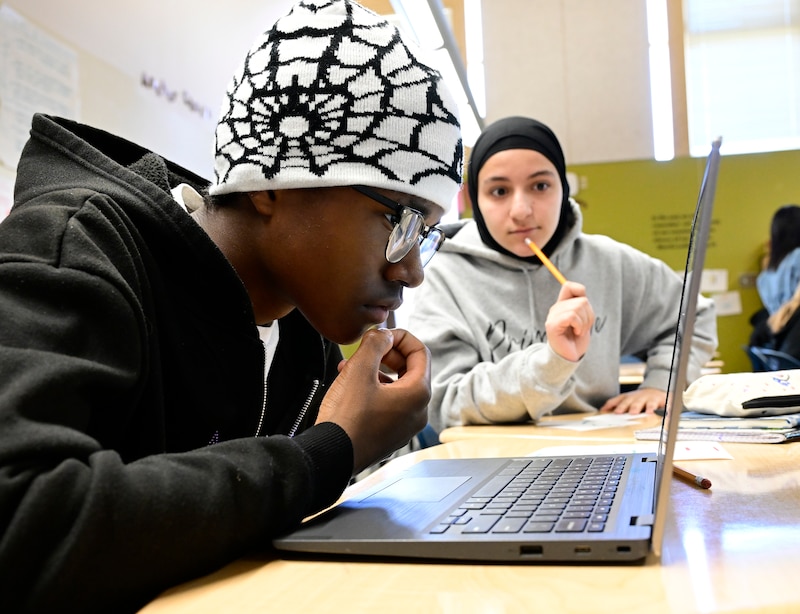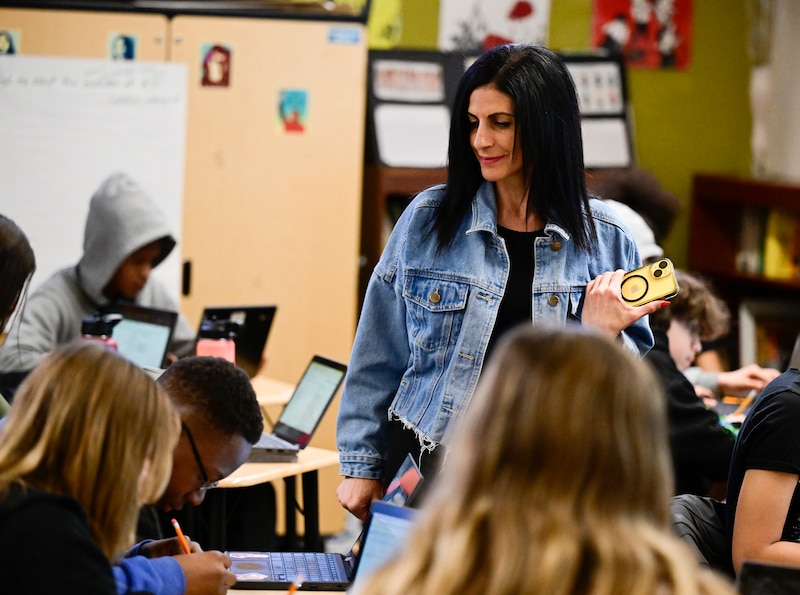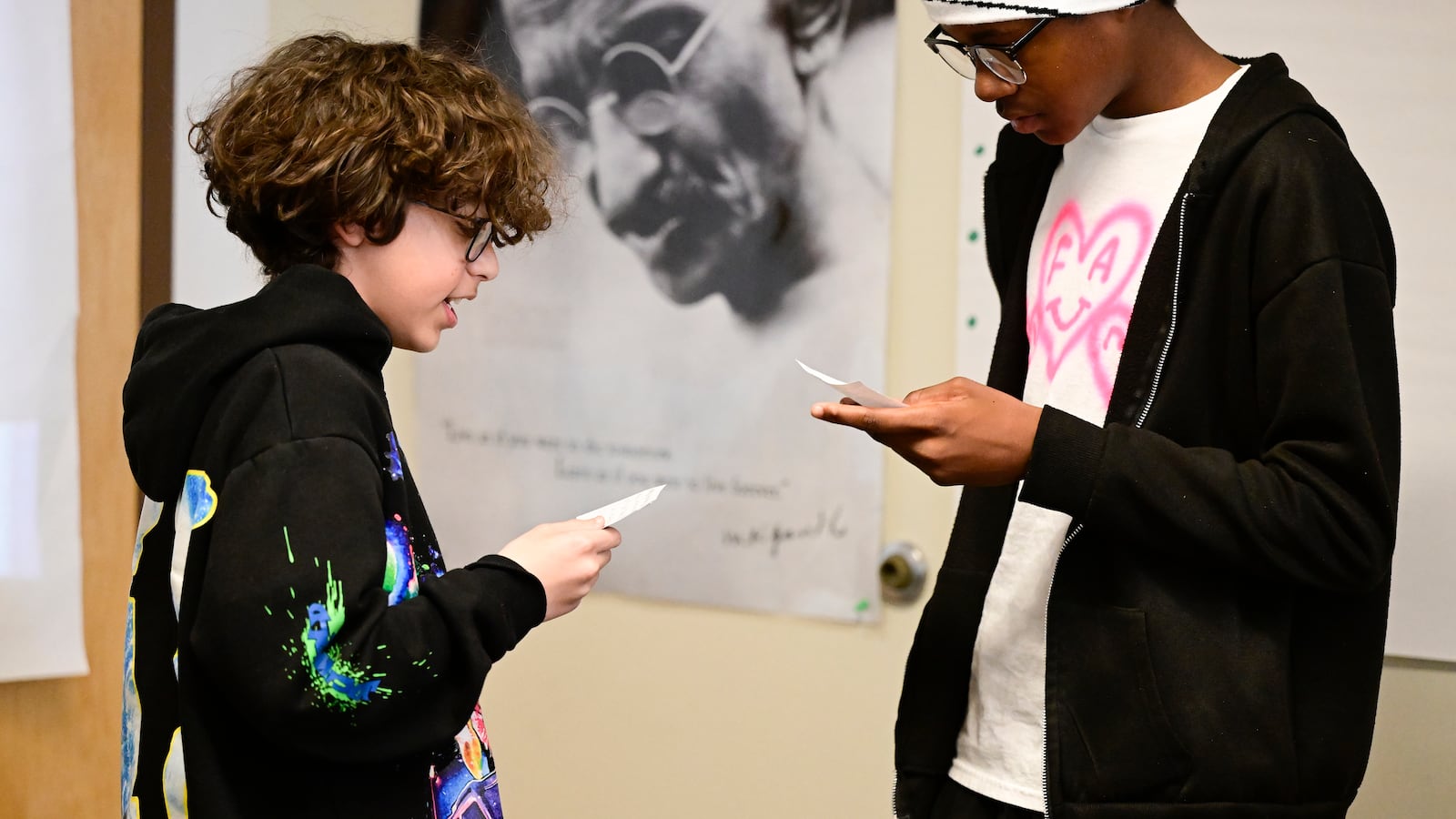Sign up for Chalkbeat Colorado’s free daily newsletter to get the latest reporting from us, plus curated news from other Colorado outlets, delivered to your inbox.
Giant easel-sized sticky notes hung on the walls of Nicole Saab’s classroom. On each, Saab had written a student’s name and a simple prompt: Ask me about banning books! Ask me about cyberbullying! Ask me about children and video games!
The topics had been chosen by her eighth grade literacy students at Denver Green School Southeast. The activity was a group brainstorming session to help guide students’ research. As Bob Marley played through the classroom speakers, Saab directed her students, pencils in hand, to move from poster to poster, writing questions about their classmates’ research topics.
“Write something you would want to know,” Saab told her students. “Be curious. Challenge that person. Like, really challenge them.”
The activity was typical of Saab’s approach to teaching: Students were up out of their seats, moving around, making noise, and engaging with each other. “No opt outs” is one of Saab’s classroom rules, although she makes exceptions for students who are tired or hungry, giving them short breaks or one of the snacks she keeps stashed in a corner.
Saab is one of 10 Denver Public Schools teachers who’ve helped their Black students achieve stellar academic progress and whose teaching methods are being studied by university researchers as part of the district’s Black Student Success work.
Saab’s syllabus includes literature ranging from George Orwell’s classic novel “Animal Farm” to rapper Tupac Shakur’s poem “The Rose That Grew From Concrete.” Saab also opens up to her students, sharing her heritage — she’s Lebanese — and her own experiences as a Denver Public Schools student whose father was a longtime principal.
“I am the warm demander,” Saab said in an interview. “I will love up on you, but I have super high expectations and this will be a rigorous class.”
Once the researchers have finished their study of Saab and the other teachers, the idea is to spread whatever effective teaching methods they find throughout the district, starting next year with six elementary schools.
“We want to be strategic,” said Michael Atkins, the district’s new director of Black Student Success. “These six schools are a learning lab so our babies can inform us of what we’re doing well or what we’re not before we full-scale do things we think will work.”
DPS has for the past five years put an emphasis on improving education for Black students, ever since the school board passed a Black Excellence Resolution in 2019. The Black Student Success team, led by Atkins, was created this school year and is the latest phase of that work. The district has budgeted $750,000 for the team’s work next year, a district spokesperson said.
About 14% of Denver’s 88,000 students are Black, and data shows the district is not serving them well. Black students are more likely to be harshly disciplined than white students, and they are less likely to score at grade level on state literacy and math tests.
The mandate of the 2019 resolution, and the idea behind the new Black Student Success work, is to change that. It’s a mission that’s personal to Atkins, who attended DPS during the era of busing to integrate Denver schools and faced discrimination and low expectations. Before he took this position, Atkins was principal of Stedman Elementary, one of Denver’s most integrated schools.
“My whole goal in education is to make sure that babies that look like me don’t have the same experience I did walking the halls of DPS,” he said.

Some principals see chance to ‘break the system’
Chris Fleming is principal of Joe Shoemaker School, an elementary school about five miles southeast of Denver Green School. Shoemaker is one the six schools in the inaugural Black Student Success cohort, all of which serve a significant population of Black students — and all of which have principals who want to do better by those students.
About a quarter of students at Shoemaker are Black, higher than the district average. Just 9% of Black students at Shoemaker met expectations on the state literacy test last spring, according to state data. That’s compared to 35% of white students who did.
The test score gap between Black students and white students — a persistent and pervasive problem at schools across the country — is the biggest issue Fleming hopes Denver’s new Black Student Success team can address districtwide.
“We want to be a place that has a lab site that’s like, ‘We’ve figured this out. We have a cadre of schools that, in my most aspirational dream, have eliminated the achievement gap,’” Fleming said. “That’s a big goal. But why not shoot for it?”
Shoemaker has had a taste of success already. For the past two years, the school has experimented with what it calls “equity cohorts.”
Each teacher picks four to seven students of color, with an emphasis on Black students, who are reading significantly below grade level, Fleming said. The teachers focus on building relationships with those students, nurturing them socially and academically. Out of about 450 students last school year, Fleming counted 187 who were getting extra attention.
When Fleming and other school leaders would go into teachers’ classrooms to observe, they zeroed in on the students in the equity cohorts. Whereas a teacher’s unconscious bias may have caused them to not call on those students as much or discipline them more, Fleming said, “when teachers knew we were watching those students, that changed.”
Test scores also improved. Although most Shoemaker students were still reading below grade level, students of color made higher-than-average gains, resulting in a splash of green on the school’s color-coded report card in a sea of yellow and red.
“That was the validation,” Fleming said. “We knew it was the right thing.”
But the equity cohorts have been harder to maintain this year, Fleming said. There are multiple reasons, including teacher turnover and a host of new district and school initiatives. That’s the reason Fleming wanted to participate in the Black Student Success work.
“Like with anything else, when you take on too many initiatives, it’s too much,” Fleming said. “Anytime you can narrow a focus, you have more success.”
Principals at other participating schools echoed Fleming.
“There are so many different competing priorities in a school district,” said Corey Jenks, principal at Columbine Elementary, located in a historically Black northeast Denver neighborhood where gentrification has caused Columbine’s Black student population to dwindle to about 21%. “I’m most excited to have a very clear, very specific and really relevant focus that I know will stay true.”
Gabriela Quiroga-Beck, principal at far northeast Denver’s Oakland Elementary, where about 20% of the student population is Black, said she was hesitant to join the cohort of six schools. She worried the initiative would be like others that gained steam but then petered out.
“But in this case, the six of us, we wanted to do something, we wanted to change the system,” Quiroga-Beck said of herself and the other principals. “So I said yes.”
“This is a great opportunity,” she added, “to kind of break the system in favor of our Black students.”

‘We have to be ruthless in our pursuit of equity’
The work is still in the beginning stages. The researchers, including Erin Anderson, an associate professor of educational leadership and policy studies at the University of Denver, are finishing their study of Saab and the other highly effective teachers.
Anderson said her hope is to pull out “actionable change ideas” that teachers at the six schools in the cohort could try in their own classrooms next school year.
“We are really trying to take research and put it back into practice,” Anderson said. “From practice to research to practice is sort of the model here.”
Meanwhile, the principals of the six schools will attend leadership training this summer through the University of Virginia, a program widely used by DPS and other districts around the country.
But first, on a Friday afternoon in March, the principals gathered in a conference room at DPS headquarters to strategize. Atkins opened the session with a metaphor.
Students, he said, are like plants. Educators are like rain. And you know those little stickers, Atkins said, that come with plants? The ones that tell you, based on the number of raindrop icons, exactly how much rain the plants need? Every student has one of those stickers.
“What is that raindrop icon for our Black students?” Atkins said.
On sticky notes, the principals wrote problems they’re trying to solve. Students being bored and unengaged in class. Too many absences. Generational trauma from bad experiences in school. The principals asked big, brainstorming-type questions about possible solutions.
“How are you getting every single kid to soak up everything you say and collaborate in small groups without you having to monitor them because they are so excited about their own success?” said Jenks, the principal at Columbine Elementary.
Denver Superintendent Alex Marrero stopped by the session. He thanked the principals for agreeing to take part in something innovative — “Is it a bit of an exploration? Yes, it is.” — and pointed to where the word “equity,” one of the district’s core values, was written on the wall.
“We have to be ruthless in our pursuit of equity beyond just the fancy words we have plastered,” he said. “I’m excited for this work — we’re putting a lot into it — and I’m excited that it’s you all.”
It’s work that, if successful, could impact how the district serves other student groups. Marrero has talked about starting a Latinx Student Success team.
Improving classroom instruction by studying teachers like Saab will likely be just one prong of the district’s plan. Saab, who spends half her time teaching and half her time coaching other teachers at her school, said she felt proud to be chosen for the study.
She conceded it’s not possible to coach personality; some teachers are naturals at connecting with students, she said, while others are not. But she said it is possible to coach best practices: “How does a classroom look more collaborative? How do you engage with a student who looks like they’re opting out? Is it punitive or do you get to know them?
“You can do the work,” Saab said of teachers. “I think that’s what’s important.”
Melanie Asmar is the bureau chief for Chalkbeat Colorado. Contact Melanie at masmar@chalkbeat.org.

